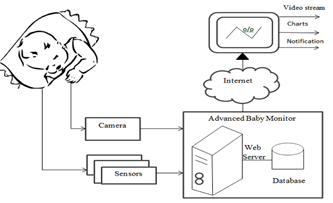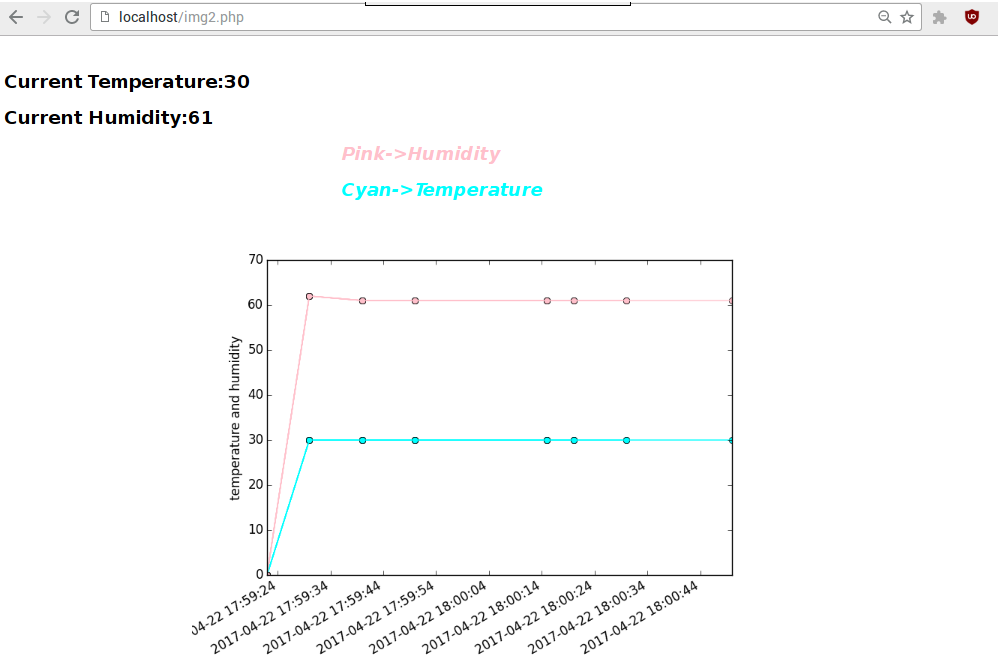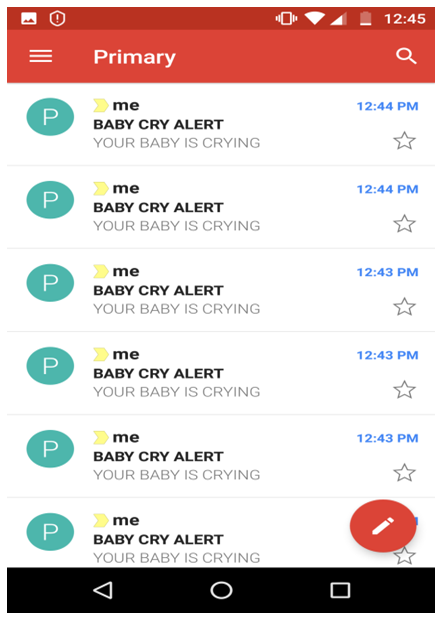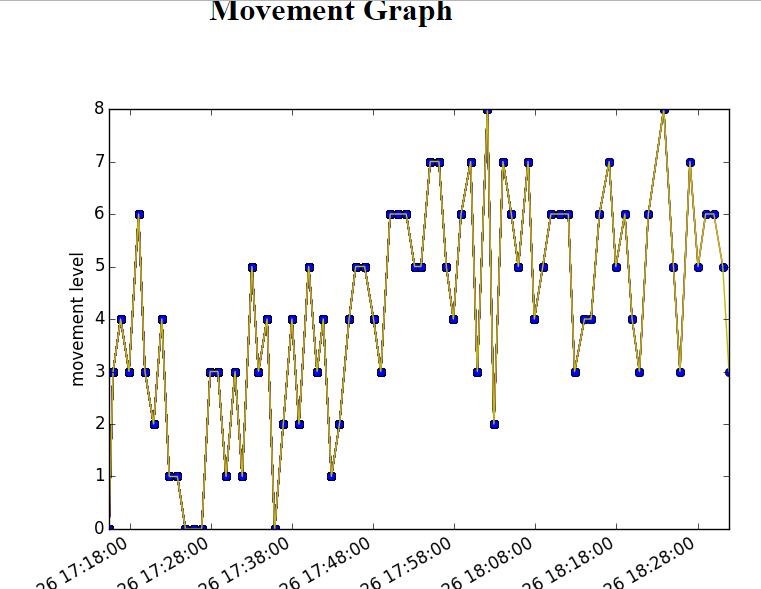-
Paper Information
- Next Paper
- Previous Paper
- Paper Submission
-
Journal Information
- About This Journal
- Editorial Board
- Current Issue
- Archive
- Author Guidelines
- Contact Us
International Journal of Internet of Things
2017; 6(2): 51-55
doi:10.5923/j.ijit.20170602.09

Advanced Baby Monitor
Shreelatha, Shreya Pai, Sonal Cynthia Pereira, Tanya Nicole, Ms Ushadevi A.
Department of Computer Science and Engineering, St. Joseph Engineering College, Vamanjoor, Mangaluru, India
Correspondence to: Shreya Pai, Department of Computer Science and Engineering, St. Joseph Engineering College, Vamanjoor, Mangaluru, India.
| Email: |  |
Copyright © 2017 Scientific & Academic Publishing. All Rights Reserved.
This work is licensed under the Creative Commons Attribution International License (CC BY).
http://creativecommons.org/licenses/by/4.0/

The baby monitoring system gives a reliable and efficient baby monitor that can play a vital role in providing better care and protection for any infant. This paper presents the design of an Advanced Baby Monitoring System using Raspberry Pi. This system monitors parameters such as temperature and humidity surrounding the infant, movements made by the infant and also would automatically log the activity and sleep cycles of the latter and act as a means by which parents could monitor their child remotely. For this it uses a camera in order for parents to view their child and it also sends a real time video to the webpage by which it provides reminders to the caretaker or rather parent. This system architecture consists of sensors for monitoring vital parameters such as temperature and humidity sensor, PIR sensor and sound sensor which would incorporate a microphone. Measurements of these parameters can be done and conveyed to the parents with an alarm triggering the system to initiate proper actions.
Keywords: Baby Monitoring, Raspbian, PuTTY, Surveillance, PIR
Cite this paper: Shreelatha, Shreya Pai, Sonal Cynthia Pereira, Tanya Nicole, Ms Ushadevi A., Advanced Baby Monitor, International Journal of Internet of Things, Vol. 6 No. 2, 2017, pp. 51-55. doi: 10.5923/j.ijit.20170602.09.
Article Outline
1. Introduction
- In today’s current scenario, with the arising difficulties, it has become necessary for both the parents to participate in the workforce and remain as active participants. This is done because with the increasing amount of expenses, meeting the daily requirements becomes hard. In such situations, mother’s in particular find it hard to move about and leave their child alone. To reason with such situations, the Advanced Baby Monitor has been designed that will be used to ease the pressure that young adults, especially the mothers of today experience. If a system is developed which continuously gives updates a child to the respective infant parent in times of illness or during the general situations, then it will be of great help to parents as they can work in a more relaxed environment by giving a more fruitful output. Also, emergency situations can be quickly noticed and handled efficiently. Usually, when an infant cries, they are generally experiencing some form of discomfort. Hence we have developed a system which can monitor the activities of a child along with finding one of the above causes and thus give this information to the respective parent.This proposed system can be used to provide reassurance to parents with infants. Several baby monitoring systems have been developed in the recent past. However the proposed system would not only include the already existing features but also include several additional features in order to help parents in the process of parenting and make this process simpler and much easier. This system can automatically send out emergency signals, and have other functions. However, the care giving methods for infants are not the same. Children require different forms of help and sufficient care in order to nurture their growth and look after their general wellbeing. Since they are unable to communicate, infants express their discomfort by crying. Hence, a home-care system specially designed for infant’s is today’s need which would substantially lighten a parent, especially a mother’s burden.The system monitors the temperature and humidity conditions in the surrounding environment of the infant, specifically near its crib. It also informs the parents through email notifications, if the child is awake and sobbing on a continuous basis. The reason for the child to weep can be linked to various other factors that this system will provide. It detects the movement of the baby and also sends notifications to the parents through email which can be viewed through any means of a smart device as well as through a personal computer. Through the means of video streaming, the parent can obtain live feeds of their child when they want and at any point of time. The system architecture consists of several sensors which are placed near the crib such as a temperature and humidity sensor, PIR sensor and sound sensor which consist of a microphone which transmits sounds of the sobbing infant to the respective parent.
2. Architecture
- A system consists of many subsystems. The architecture of the system identifies the major components of a system and communication between those components. The figure given below indicates and architectural overview of the proposed project. The major components are the caretaker, raspberry pi, various sensors such as PIR sensor, temperature and humidity sensor, various LED’s, camera module for video and audio streaming and a display.
 | Figure 1. Architecture of baby monitoring system |
2.1. Temperature and Humidity Sensor
- The temperature and humidity sensor, on connection to the raspberry pi is used as an enhanced tool that would help determine the variations in the temperature and humidity in the surrounding environment of the infant. This sensor would regularly detect the temperature and humidity in the room where the infant’s crib resides and plot it on a graph which would be displayed on the webpage. We make use of a database to store the values and hence display the values. The graph shows variations in temperature and humidity plotted against time and the date on the x-axis. On refreshing the webpage the graph would show newer values and hence help parents understand the temperature and humidity conditions in the surrounding area of the baby and determine if there is any discomfort caused due to the same.
2.2. PIR Sensor
- The PIR sensor on connection to the Raspberry Pi would be used to detect any movement of the infant. It would track regular movements of the infant to determine its activity levels and also in order to inform the parents of the awakening of the infant. A real time graph would be plotted of the same and hence displayed on the webpage to keep the parents up to date with the movement cycle of the infant.
2.3. Notification Alarm System
- This system has been developed in order to alert the caretakers of the infant in case of certain criteria such as vaccination dates that are approaching or even feeding time. The initial dates would have to be fed into the database to be stored and then as the day comes by, the parent would receive an email notification reminding the parent that they would have to take their child for their next vaccination. In the case of feeding time, the initial date and time would be entered and the interval too for the reminder. Given the stipulated interval, the reminder in the form of email notifications would be sent to the parent reminding them to tend to their infant and feed it. This system also alerts the parent if the infant’s cry has been detected for a prolonged period of time.
2.4. Camera Module for Video Streaming
- The product uses camera for surveillance of the baby and sends a real time video and audio to a webpage so that they can monitor their infants remotely and react based on the alerts provided by the system.
2.5. LED’s
- The system consists of a smart sound sensor that would detect when the baby is crying and inform the parents through a set of LEDs. This would be beneficial to the parents with hearing disabilities.
2.6. Display
- Display can be a phone display for laptop display where all the notifications is sent and fed for future reminders and also streaming can be done.
3. Operating System
- Raspbian is a free operating system based on Debian optimized for the Raspberry Pi hardware. An operating system is the set of basic programs and utilities that make your Raspberry Pi run. However, Raspbian provides more than a pure OS: it comes with over 35,000 packages; pre-compiled software bundled in a nice format for easy installation on your Raspberry Pi. The initial build of over 35,000 Raspbian packages, optimized for best performance on the Raspberry Pi. However, Raspbian is still under active development with an emphasis on improving the stability and performance of as many Debian packages as possible. The new Raspberry Pi configuration allows you to enable and disable interfaces, tweak performance and configure internationalization options, such as time zone and keyboard.
4. Proposed System
- On getting the Pi, the SD Card is needs to be written with its desired OS. After doing the above, insert the SD Card into the Raspberry Pi. DC power is to be supplied to the Pi either though a Power bank or a power socket. Finally the Raspberry pi is connected to a laptop though an Ethernet LAN cable. Once PuTTY is installed, through an IP address it can access command window of pi. Though this command window various programs are executed.
4.1. Video Streaming
- For this first we need to connect USB camera to the raspberry pi through the USB port. We use a MJPG streamer to continuously stream the live video to the website. MJPG streamer is a command line application that copies JPEG frames from one or more input plugins to multiple output plugins. The parents can view the live video of their baby through web interface using various devices like laptop, mobile phones, etc.
4.2. Cry Detection
- For this a Noise sensor is first connected to the raspberry pi with its out pin connected to a specific gpio pin. When the sensor detects a noise, it outputs a low signal. This value is accessed in the program though the specified gpio pin. For each low signal detected, a counter is incremented and when this counter reaches a preset value, it is considered as continuous cry from the baby and an email notification is sent to the users. Current temperature of the room is also noted as it can be one of the reasons for baby being uncomfortable and crying. As a way of calming the baby soothing music is played using the speaker.
4.3. Movement Detection and Graphing
- Similar to the noise sensor, here PIR sensor is connected to the pi. This sensor first adjusts itself to the infrared signals emitted by the baby in front of it. When baby moves around resulting in change in the infrared values the PIR sensor returns a high signal. Again this value is accessed in the program and a counter is incremented.This counter value specifies the number of movements detected from the baby. For every preset period of time, the counter value and the current time are stored in an array which is then passed to a plotting function. This function draws a graph with time in x-axis and the counter value in y-axis. Over time when graph is populated with values of movements, analysis is done about how much time baby was in deep sleep showing no movement, and how much is the average movement of baby, finally too much movement denoting that baby is probably uncomfortable because of some reason.
4.4. Temperature and Humidity Detection and Graphing
- The temperature and humidity sensor is connected to the raspberry pi similar to other sensors. However this time value read is not just high or low, instead the actual temperature and humidity values are read, these values are converted into a correct format by the adafruit_dht package. Again for every pre-set time the temperature and humidity values with corresponding time are stored in two arrays and passed as parameters to the plotting function. The graph produced shows the variation of temperature and humidity over a period of time. By analyzing this data and comparing against the movement graph and also cry detected data, it could be found as one of the possible reason for the baby to be uncomfortable.
4.5. Reminder System
- Using this feature, parents or caretakers can set reminder about feeding time and vaccination date. Here first they would have to enter the date and time when they want to get the reminder, then this data is stored in database and is continuously checked against current date and time. When a match is found email notification is sent to the users.The proposed system’s UI has been made very interactive in order to help the used visiting the webpage, such that they find their task of operation simple. Hence a certain level of simplicity has been made to help users figure out the whereabouts easily. Once the user has registered with the respective system password, the user will only then be permitted to login successfully. On logging in, the user enters the home page. The home page, a very attractive one, has several buttons in order to redirect the user to a whole new page on clicking a specific button. Hence each button would be used to provide redirection to a whole new page with some functionality that the user would require. There are a total of 4 buttons. They are used to navigate to the pages showing the temperature and humidity graph, movement graph, video stream and lastly notification. On moving the mouse over each of them, a pop up would appear giving a description on what each button would imply. Lastly there exists the sign out button which would lead the user back to the login page.
5. Results
- Thus we have introduced an Advanced Baby Monitoring System. This system is capable of sending a live video stream of the baby using the camera to a webpage, accessible through both mobile phones and laptop. The system also provides an important functionality of listening to baby’s cry though a sound sensor and then alerting the parents with an email notification. On detecting the child’s cry, the LED’s blink and a lullaby would play simultaneously in order to help train the child to self soothe. Additionally this system logs the baby’s movements detected using a PIR sensor and produces a graph which show variations of movements with respect to time. Using temperature and humidity sensor it produces another graph which shows varying temperature and humidity values in the room. Finally the system also sends reminders to the parents about approaching vaccination dates and feeding time.
5.1. Temperature and Humidity
- The figure shows a graph of temperature and humidity plotted against the time. It shows the variation in temperature and humidity in the environment surrounding the infant over a period of time.
 | Figure 2. Graph for temperature and humidity values |
5.2. Notification System
- When infant’s cry is detected parents are notified by sending an email notification. This helps parents to quickly respond and take care of the infant. Other than this, parents can set notification for vaccination date and feeding time and get corresponding alert on those days.
 | Figure 3. Cry detected notification on phone |
5.3. Activity Levels
- The infant’s movements in its sleep are recorded using a PIR sensor and plotted against time. Many points in graph at level 0 indicate that infant is in deep sleep. Points level 7 and 8 indicate that infant is moving around rapidly maybe because it is uncomfortable or excited.
 | Figure 4. Graph for activity levels |
6. Applications
6.1. At Home
- This system helps the parents and caretaker to monitor their baby without actually being at the baby’s bedside. Video streaming helps them to get the live stream of the baby’s activities. The Temperature and humidity sensor displays the temperature and humidity of the baby’s environment. The PIR sensor used in this system regularly detects the baby’s movement. Graphical representation of temperature and humidity as well as movement values helps the parents to analyze the data more easily. Notifications received on detection of the infant’s cry helps the parents understand that their child is experiencing some level of discomfort. Notifications on approaching feeding times and nearing vaccination dates helps to keep the parents up to date and be punctual in feeding their baby at appropriate times.
6.2. Hospital Purposes
- This system helps them to check the discomfort of the newborn in various temperature and humidity conditions. For premature babies, during the initial treatment, parents are not allowed to be present near the baby physically as germs and infections could transmit easily since they have a low immunity tolerance. Thus in such situations video streaming would help the parents to see their baby without actually being in the room where the baby is physically. When the babies are present in NICU, the video streaming and notification on cry detection helps the nurses, doctors and other staff in charge to take immediate action.
7. Conclusions
- It shows the variation in temperature and humidity in the environment surrounding the infant over a period of time. The Advanced Baby Monitor is a project developed to touch the lives of parents and ease their ways of operation. It has been pumped with several functions sufficient enough to ease the workload of parents. The functions offered by this device will look after the basic wellbeing of the child and thereby provide notifications to parents when their baby is in need of them. Hence setting aside their workload doesn’t stand as an option.This device includes several specifications in order to reassure parents with the safe handling of their child. It monitors the temperature and humidity around the child so as to determine if the child is experiencing some level of discomfort. It also monitors the activity levels of the child and provides streaming. The video received by the parent on the webpage will be a live video. In case the child cries, music will be played to help the child learn to self soothe. Apart from these specifications several others can be included in order to make the device more interactive and better.In future, the Advanced Baby Monitor can be used to implement automatic cradling in times when the baby wakes up or if the baby weeps. It can be used to help parents teach their children to self soothe. Another feature that can be implemented is spoutling which is a small ankle bracelet worn by the infant that monitors factors like the heartbeat etc. Having a video camera with image processing, it can be used for security purposes to determine if there are any intruders.
 Abstract
Abstract Reference
Reference Full-Text PDF
Full-Text PDF Full-text HTML
Full-text HTML